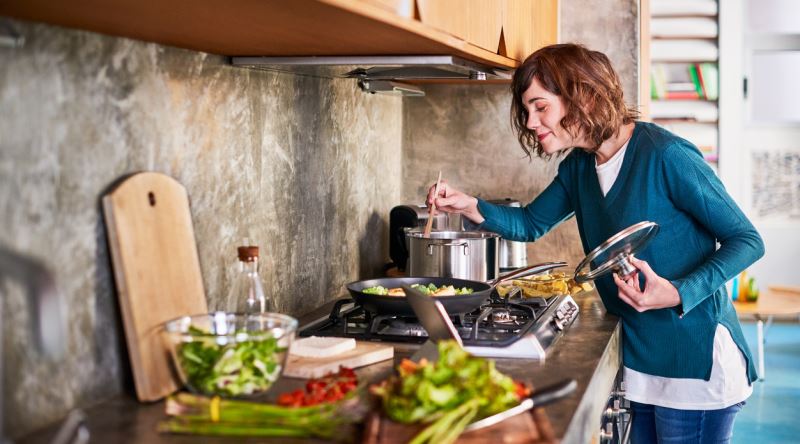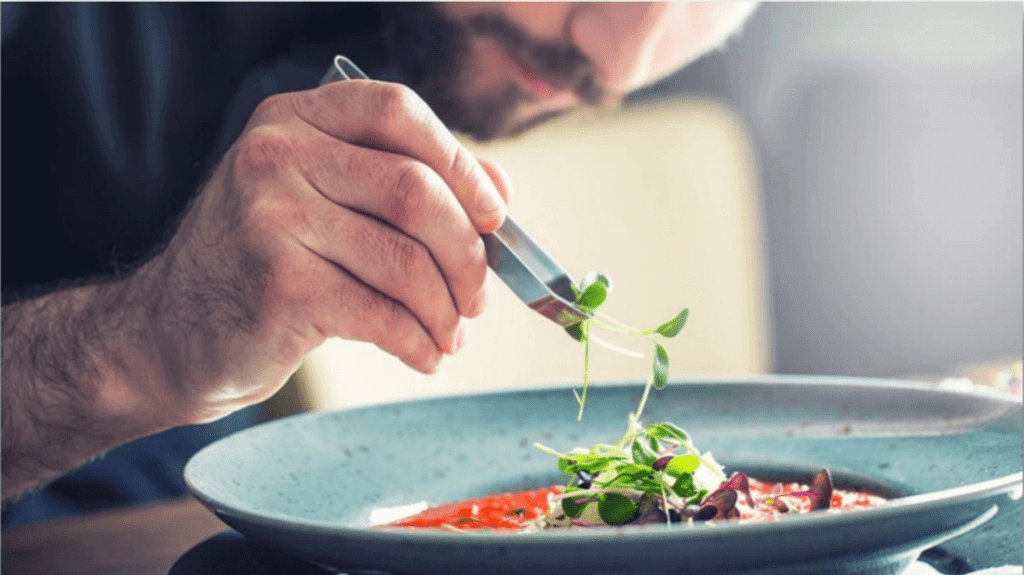Hello food enthusiast friends! Today I will share with you the tips to improve your skills in the kitchen. We all have little tips we need from time to time to be more successful in the kitchen. Here are practical and effective skill development suggestions:
Use the Right Tools: There is a tool for every job. It is important to choose the right knives, pots and pans that will make your work easier in the kitchen.
Learn Basic Techniques: Learning and applying basic cooking techniques such as roasting, baking and boiling will give you great mastery over time.
Read Recipes Thoroughly: Reading a recipe thoroughly and preparing the ingredients in advance will keep you from being caught off guard.
Experiment with Flavor: Discover your own style by trying different ingredients, spices and cooking methods.
Don’t be afraid to make mistakes: Making mistakes in the kitchen means trying new things. Learn from your mistakes and do better next time you try.
Progress Slowly: It is not possible to learn everything at once. Be patient and improve your skills step by step.
Remember, mastering the kitchen may take time, but with patience and passion, you can get better every day. I wish you pleasant cooking experiences in advance!
Basic Cooking Techniques and Practical Tips
The basis of success in the kitchen lies in knowing and applying correct cooking techniques. Here is some basic information that can help you with this:
Roasting Technique: Roasting is a short-term cooking method over high heat. Ideal for roasting your meat or cooking your vegetables quickly. Fast cooking at high heat ensures that the ingredients become crispy on the outside while preserving their flavor.
Boiling Technique: Boiling is the cooking of ingredients in water at low temperatures. It is used to boil ingredients such as vegetables, pasta or eggs. The cooking time of the ingredients and the amount of water are important.
Sauteing Technique: Sauteing is a method of cooking quickly in oil over medium heat. Fast and delicious meals are obtained by sautéing vegetables, meat or seafood. The ingredients are stirred frequently to cook evenly.
Baking Technique: Baking is the cooking of ingredients at low or medium temperature. Meats, vegetables or pastries are slowly cooked in the oven. With this method, the ingredients brown on the outside while they cook on the inside.
Steaming Technique: Steaming is based on water vapor cooking the ingredients. It reduces the use of fat while preserving the taste and nutritional values of foods. Vegetables, fish and eggs can be cooked healthily with this method.
Grill Technique: Grilling is a cooking method using direct fire or a high heat source. Delicious and aromatic flavors are obtained by grilling meat, vegetables or fish.
Learning and practicing these basic cooking techniques will make you more skilled in the kitchen. It is important to choose appropriate ingredients for each technique and pay attention to cooking times. You can improve yourself by practicing. We hope you have pleasant cooking experiences!
Mastering Cutting and Chopping Techniques
Cutting and chopping food correctly ensures that your meals are both visually elegant and provide better results in terms of taste. Here is some basic information that can help you with this:
Choosing the Right Knife: It is very important to choose the right knife for a good cutting process. Generally, pointed and wide-shaped knives, such as chef’s knives or santoku knives, allow you to grip a large surface and provide a more controlled cut.
Correct Holding Technique: Holding the knife correctly greatly affects the success of the cutting process. It is important to ensure both safety and control by gripping the knife, supporting it with fingers and palm, and correct cutting movements.
Ingredient Preparation: Preparing food before cutting makes your job easier. Pre-chop vegetables, fruits or meat to the appropriate size and thus save time during cooking.
Julienne and Brunoise Techniques: Chopping vegetables in julienne or brunoise will add a professional touch to your meals. Julienne chopping means cutting into long thin strips, while brunoise chopping allows you to get small and neat cubes.
Chiffonade Technique: Used to cut leafy greens or herbs into thin strips, the chiffonade technique provides a decorative look for salads or dishes.
Dicing Technique: Cutting food into regular cubes is important, especially for side dishes or pilafs. Having equal sizes of ingredients helps balance cooking times.
Learning and practicing cutting and chopping techniques may take time, but you can improve these skills with practice. You can become more comfortable and skilled in the kitchen by trying each technique step by step. We hope you have pleasant cooking experiences!
Creative Presentations: The Art of Plate Arrangement and Garnish
Cooking is not just limited to preparing delicious meals; You can also make your meals visually appealing. Here are some practical tips that can help you with this:
Color Balancing: It is important to use colors in a balanced manner in plate arrangement and presentation. Add visual appeal to your plate by using vibrant colors such as green, orange or red along with the natural colors used in dishes.
Plate Selection: The choice of plates you will use to present your meals also affects the quality of your presentation. While simple and plain colored plates generally make your meals stand out, patterned or specially designed plates can also enrich your presentation.
Plate Arrangement Techniques: You can use different techniques to create an aesthetic order when placing dishes on the plate. For example, you can create symmetry by placing dishes in the center of the plate and adding garnishes around them, or maintain balance by placing them evenly on both sides of the plate.
Use of Garnishes: It is important to use garnishes correctly, which add visual and taste value to your meals. You can enrich your meals with fresh greens, spicy sauces or colorful vegetables.
Minimalism and Aesthetics: In some cases, less is more. You can present your meals in a simple and stylish way by adopting a minimalist approach to plate arrangement. You can focus on your meal by leaving free space.
Experimentation and Inspiration: Be bold and try different editing techniques for creative presentations. You can develop your own style by examining interesting presentations you see on the internet or in restaurants.
Food presentation is an important part of the dining experience and can further enhance the taste of meals with its visual aesthetics. Always try new things and don’t be afraid to find your own style. We hope you have enjoyable and creative food presentations!
Skills in Using Professional Kitchen Equipment
Professional kitchen equipment can make your food preparation process more efficient and the results higher quality. Here is some basic information that can help you with this:
Chef Knife: The chef knife is the most used and versatile tool in the kitchen. It is used in operations such as chopping, cutting and filleting. You can make your meal preparation easier by holding the knife correctly and learning cutting techniques.
Cast Iron Pan: Cast iron pans are known for their high heat resistance and are ideal for searing meats or baking baked dishes. You can ensure long-lasting use by learning how to season and clean your pan.
Food Processor or Blender: Especially useful when making sauces, purees or pastries, food processors and blenders are ideal for quickly processing ingredients and obtaining a homogeneous mixture. Learn how to work with different components.
Steel Pot and Pan Set: Quality steel pots and pans are the main tools used to enhance the cooking experience. It is important that they transmit heat evenly and preserve the flavor of the dishes. Learn how to clean and care for pans and pots.
Cooking Thermometer: A thermometer, especially used when cooking meat or making sugary mixtures, makes the cooking process more precise and helps you achieve the desired temperature.
Silicone Spatula and Tongs: Silicone spatulas and tongs are ideal for use in non-stick coated pots or for mixing delicate mixtures. You can ensure long-term use by choosing quality silicone tools.
You can increase the efficiency and results of your food preparation process by using professional kitchen equipment. You can improve yourself by practicing the use of each piece of equipment. Remember, work done with the right tools is more enjoyable and successful. We hope you have pleasant culinary experiences!
Balance of Flavors: Adjusting Salt, Sugar, and Acidity
Correctly adjusting salt, sugar and acidity while cooking significantly affects the taste of your food. Here are some important points that can help you with this:
Proper Use of Salt: Salt is essential to adding balance and depth to your food. However, excessive use of salt can spoil your meal. While cooking the food, add salt little by little and taste to find the right balance.
Role of Sugar: Sugar is used to balance the bitterness or sour taste in foods. Adding a little sugar, especially for sauces with tomato paste or tomato, can reduce the bitterness and soften the flavor.
Increasing Acidity: Ingredients that increase acidity, such as lemon juice, vinegar or pickle juice, add zing to your food. You can enrich your meal by using balanced acidity, especially in fish, salads or meat marinations.
How to Achieve a Balance of Taste?: To balance salt, sugar and acidity in your food, first read the recipe well and prepare the ingredients in advance. Taste the food constantly throughout the cooking process to adjust the taste and make adjustments if necessary.
Personal Preferences: Personal preferences are important when it comes to adjusting salt, sugar and acidity. Since everyone’s taste is different, you can adapt the recipe to suit yourself. However, it is important to create an overall balanced flavor profile.
Trial and Error Method: You can gain experience in the balance of flavors by trial and error. You can achieve the perfect taste of your food by adding salt, sugar and acid slowly and measuredly.
Getting the balance of flavors right during the cooking process can make your meals taste as delicious as professional chefs do. You can improve yourself with practice and open trials. It is important to see and enjoy every meal as a taste adventure. I wish you pleasant cooking experiences in advance!
See you in the next post,
Anil UZUN

